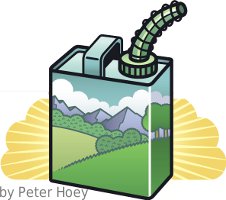Although the specifics may have since changed, this chart from Bio Hope, Bio Hype in the September 2007 issue of the Sierra Club’s magazine provides a nice overview of the major biofuel options.
What about moving Beyond the Corn Field: Balancing Fuel, Food and Biodiversity? After all, if there’s one thing that thing that our reliance on fossilized sunlight has taught us, it’s that that there should be room for every fuel that makes ecological (and economic) sense. Indeed, there are a number of exotic fuel feedstocks you are probably not yet familiar with. Indeed, on Earth Day the Navy tested a bio-blend jet fuel made from 50% German sesame seed oil. What of the much touted cellulosic ethanol? An alternative to the use of sugary food crops, or the relatively low-yield plant-based oils. In February University of Wisconsin researchers published a paper with details about a mechanism for efficiently converting an intermediate product that may be derived from sugar or cellulose into a high-grade liquid fuel.
Despite these and other advancements, more evidence is coming to light that biofuels are not without ecological costs including biodiversity as linked above, and soil degradation. In the end, it will be a balancing act, with conservation and efficiency offering the highest yield.
While not specifically about biofuels, the agri-business exposé King Corn is being shown at the Main Library next Tuesday evening; it has its detractors though.


Pingback: Tweets that mention Warm Home Cool Planet » Blog Archive » Burning breakfasts for bus fuel -- Topsy.com